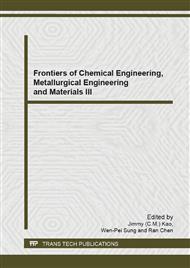p.624
p.628
p.633
p.638
p.642
p.646
p.651
p.655
p.660
Biooxidation of High-Sulfur Refractory Gold Concentrate by Ferroplasma acidiphilum
Abstract:
Gold ores can be categorized into two types-free milling and refractory. Free milling ores are easy to treat. Gold in such ores is recovered by gravity separating techniques or direct cyanidation. Refractory gold ores, on the contrary, are difficult to treat and require pre-treatment prior to cyanidation, such as roasting, pressure oxidation, fine grinding and biooxidation. A number of bacteria are used in biomining but the prominent ones that are known to be involved in the oxidation of sulfide ores include Thiobacillus ferrooxidans, Thiobacillus thiooxidans and Leptospirillum ferrooxidans. In this study, the gold concentrate was biooxidized in a reactor at 45°C over a period of 10 days at a pulp density of 15% solids using a culture of already grown Ferroplasma acidiphilum. The initial pH was adjusted to 1.5 with sulfuric acid, resulted in 85.39 % oxidation of sulfur from initial grade of 33.83 %, and the slag rate was 68.52 %. The products of sulfide biooxidation were leached at a pulp density of 20 %(v/w) for 24 h at pH 11. The pH was adjusted using CaO and cyanide strength was 10 kg/t, we got a gold extraction of 90.71 %, which ncreaseed 80.09 % compared with the direct cyanide leaching.
Info:
Periodical:
Pages:
642-645
Citation:
Online since:
August 2014
Authors:
Price:
Сopyright:
© 2014 Trans Tech Publications Ltd. All Rights Reserved
Share:
Citation:


